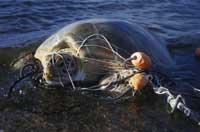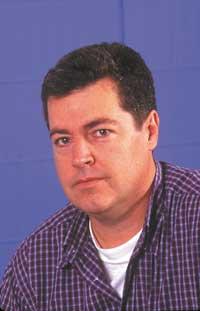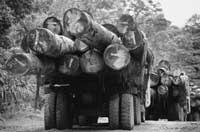Juantxo López de Uralde, Spanish director of Greenpeace
2001/06/21 Mendiburu, Joana - Elhuyar Zientziaren Komunikazioa
Juantxo López de Uralde, director of Grenpeace in Spain, gave a lecture on June 19 at the Aquarium of San Sebastian on sea pollution. This woman from San Sebastian, with extensive experience in ecology, along with the finding that pollution is diverse and has a global impact, highlighted the need to establish international agreements to achieve a solution.
What are the main problems encountered in marine ecosystems?
The effects on marine ecosystems are varied. On the one hand, I would say that the sea explodes too much and more and more. Since 1995 the number of catches has multiplied by five. 16% of the animal protein consumed per capita and 26% of the oil used comes from the sea.
On the other hand, the introduction of species, the reduction of habitats and the effects of all types of pollution.
What are the main marine pollutions?
The sea collects a large quantity and variety of waste, from the most visible to persistent organic pollutants. Two groups can be distinguished between natural substances and artificial or chemical substances.
Natural substances are mainly thrown into dirty waters and, although in normal concentrations nature is able to assimilate them, excessively high concentrations cause an imbalance in ecosystems.
Synthetic substances are rough (90% plastic), heavy metals and persistent organic pollutants, including hydrocarbons, pesticides known as DDT, lindane, dioxins produced in incinerations, PCBs used as transformer insulators, etc. Nature lacks mechanisms of degradation of synthetic waste.
Are the residues of the second group more harmful?
Most of the organic waste is thrown into the dirty water of cities, generating imbalances in ecosystems. In fact, these residues present a high degree of nitrogen and phosphorus and provoke reactions such as eutrophication, frequently causing the mass death of fauna and flora due to lack of oxygen.
Artificial substances also cause death, but otherwise. For example, the ingestion of large plastic waste allows asphyxiating animals (turtles, birds...). In the Bay of Biscay, for example, there are 50 million objects at a depth of 0-200 meters! and in the North Sea are fired 70,000 m 3 sharp from the ships! The amount of these residues is therefore not negligible.
Heavy metals accumulate in fatty tissues and as they advance in the trophic chain concentrations increase. Metals cause abnormalities in the sex organs of animals or tumors and cancers.
In addition, the mechanism called distillation allows the movement of sustainable waste. First they climb into the atmosphere, there they move from one side to another and then precipitate. Therefore, it is not surprising, for example, the presence of heavy metals in the Arctic bears.
He said we launched natural waste in dirty urban waters. What are the origins of chemical waste?
The main origin of chemical waste is industry. Industrial areas are located in the vicinity of rivers and ports and throw high concentrations of waste. As we recall, industries have left such dramatic examples as Doñana.
Similarly, the dredging of the soil of the ports also suffers huge damage. This is because the dredging land is expelled a thousand further, so that by increasing the amount of suspended substances there is contamination of another ecosystem due to the abundance of pollutants.
Finally, we cannot forget the 27,000 ships that circulate from one side to the other.
What kind of pollution do ships cause?
Ships cause conventional and accidental contamination.
Typical pollution, garbage, products thrown when cleaning the boat and TVD paintings. These paintings prevent the proliferation of microorganisms and algae on the outside of the boat, so neither does the proliferation of plankton occur in the vicinity.
In addition to the usual ones, like the sad examples we have seen in this winter, there are also accidents contaminations. Normally the spill is oil. But as in the case of Ievoli Sun styrene was fired, other chemicals have also been released. The oil that is launched through these accidents represents 12% of the output to the sea.
What are the damage caused by these spectacular accidents?
These accidents on ships have two consequences, momentary and long-term. First, since most of the time the accident occurs in adverse weather conditions, the extent of the stain is easy. The species directly affected are birds.
Over time the molecules are broken and smaller carbon chains are created. Nature takes between 10 and 15 years to turn around this type of spills.
What can be done in these cases to reduce damage?
They usually try to stop the spread of the stain with chemicals, but it is worse. In fact, with these chemicals is achieved the formation of oil balls that with their weight go to the subsoil of the sea. Thus, oil is out of sight, but it does not disappear! They only make the problem worse.
The only solution is to strengthen the safety measures of ships. Now, oil companies and insurers, until the interest of the media diminishes, pass a ball of responsibility. Then the compensation is paid to the fishermen, and that's it! Ecosystems are still damaged.
More and more accidents, persistent organic pollutants... Like many other things, can one say that the problem of marine pollution is globalizing?
Yes, no doubt. Pollutants move from one side to the other and seemingly uncontaminated places. It is increasingly difficult to find uncontaminated sites. It is a global problem.
So will the solution also have to be global?
Yes, the solution will be achieved with international agreements, and that has been demonstrated by the experience of 30 years. For example, as leaded gasoline has been banned, the concentration of lead in the atmosphere has been reduced. Given these types of examples, it is time to put aside the concept of dilution to boost productions without waste.
For practical examples, the implementation of legislation for the collection of waste equipped by the port and the purification of all urban wastewater must be done as soon as possible.
Experienced man
Juantxo López de Uralde has been Spanish director of Greenpeace since May. The 37-year-old from San Sebastian began working on ecology around 1980. First he worked in a small group of the university and from there he went to the CODA (Coordinator of the Organizations of the Defense of the Birds), meeting place of small groups of the region that worked in defense of the birds. Over time, CODA went from being a bird advocacy group to being an environmental advocacy group. Today it was a step towards the so-called Ecologists in action.
In 1987 he entered Greenpeace to lead the campaign against incineration. There was a project to incinerate industrial waste in the Cantabrian, which led a campaign against it, until the authorization granted by the Government was revoked. Subsequently the campaign continued in the North Sea and plunged into toxic and energy campaigns.
In 1999 she moved to Greenpeace International as coordinator of the international campaign against toxins.

Gai honi buruzko eduki gehiago
Elhuyarrek garatutako teknologia






